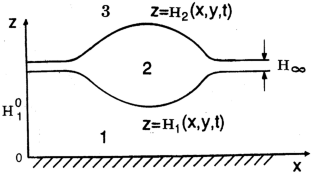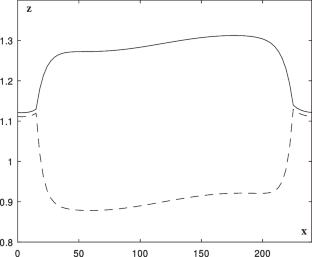一维空间温度调制对自下而上加热的漂浮液滴动力学的影响
IF 1.3
4区 工程技术
Q2 ENGINEERING, AEROSPACE
引用次数: 0
摘要
研究了液态基底上的液滴在自下而上不均匀加热情况下的动力学。在细长液滴近似和前驱体模型的框架内对该问题进行了数值研究。研究了静止液滴形状的变化以及浮动液滴引起的基底层破裂。研究了重力对液滴形状的影响。本文章由计算机程序翻译,如有差异,请以英文原文为准。


The Action of One-dimensional Spatial Temperature Modulation on Dynamics of a Floating Droplet Heated from Below
The dynamics of a droplet on a liquid substrate in the case of an inhomogeneous heating from below has been investigated. The problem is studied numerically in the framework of the slender droplet approximation and the precursor model. The change of the stationary droplet’s shape and the rupture of the substrate layer induced by a floating droplet are investigated. The influence of the gravity force on the shape of the droplet is studied.
求助全文
通过发布文献求助,成功后即可免费获取论文全文。
去求助
来源期刊

Microgravity Science and Technology
工程技术-工程:宇航
CiteScore
3.50
自引率
44.40%
发文量
96
期刊介绍:
Microgravity Science and Technology – An International Journal for Microgravity and Space Exploration Related Research is a is a peer-reviewed scientific journal concerned with all topics, experimental as well as theoretical, related to research carried out under conditions of altered gravity.
Microgravity Science and Technology publishes papers dealing with studies performed on and prepared for platforms that provide real microgravity conditions (such as drop towers, parabolic flights, sounding rockets, reentry capsules and orbiting platforms), and on ground-based facilities aiming to simulate microgravity conditions on earth (such as levitrons, clinostats, random positioning machines, bed rest facilities, and micro-scale or neutral buoyancy facilities) or providing artificial gravity conditions (such as centrifuges).
Data from preparatory tests, hardware and instrumentation developments, lessons learnt as well as theoretical gravity-related considerations are welcome. Included science disciplines with gravity-related topics are:
− materials science
− fluid mechanics
− process engineering
− physics
− chemistry
− heat and mass transfer
− gravitational biology
− radiation biology
− exobiology and astrobiology
− human physiology
 求助内容:
求助内容: 应助结果提醒方式:
应助结果提醒方式:


